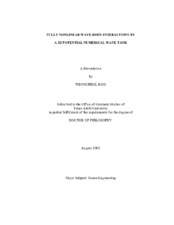| dc.description.abstract | A 2D fully nonlinear Numerical Wave Tank (NWT) is developed based on the potential theory, mixed Eulerian-Lagrangian (MEL) time marching scheme, and boundary element method (BEM). Nonlinear Wave deformation and wave forces on stationary and freely floating bodies are calculated using the NWT. For verification, the computed mean, 1st, 2nd, and 3rd order wave forces on a single submerged cylinder are compared with those of Chaplin's experiment, Ogilvie's 2nd-order theory, and other nonlinear computation called high-order spectral method. Similar calculations for dual submerged cylinders are also conducted. The developed fully nonlinear NWT is also applied to the calculations of the nonlinear pressure and force of surface piercing barge type structures and these obtained results agree with experimental and theoretical results. Nonlinear waves generated by prescribed body motions, such as wedge type wave maker or land sliding in the coastal slope area, can also be simulated by the developed NWT. The generated waves are in agreement with published experimental and numerical results. Added mass and damping coefficients can also be calculated from the simulation in time domain. For the simulation of freely floating barge-type structure, only fully nonlinear time-stepping scheme can accurately produce nonlinear body motions with large floating body simulations. The acceleration potential method, which was developed by Tanizawa (1996), is known to be the most accurate, consistent and stable. Using acceleration potential method, in the present study, the series of motions and drift forces were calculated over a wide range of incident wave frequencies including resonance region. To guarantitatively compare the nonlinear contribution of free-surface and body-boundary conditions, the body-nonlinear-only case with linearized free-surface condition is separately simulated. All the floating body motions and forces are in agreement with experimental results. Finally, the NWT is extended to fully nonlinear wave-body-current interactions of freely floating bodies, which has not been published in the open literature until now. | en |


